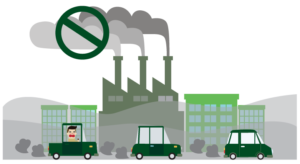In 2013, the Paramount Refinery began converting portions of the oil refinery into renewable fuels production. In 2018, World Energy purchased AltAir and the Paramount Refinery, and AltAir became a wholly owned subsidiary of World Energy. Under World Energy, AltAir proposes to complete the conversion of the refinery to manufacture only renewable fuels at a higher level than originally approved by the City. On April 11, 2022, the City Council approved an amendment to Conditional Use Permit (CUP) No. 757 to proceed with construction and the conversion of the refinery. The City Council also approved Zone Variance No. 409, which will allow some refinery equipment to exceed the 55-foot height limit.
Fact Check
FACT: The final Environmental Impact Report [EIR] provides extensive analysis and information on a whole range of issues under CEQA, and followed all CEQA requirements utterly and completely. Multiple agencies, including the AQMD, were involved in its review and preparation, and all information has been available to the public.
FACT: The refinery has never been even close to “shuttered.” Since shifting over to the production of biofuels, its output has decreased from when it was producing petroleum products. But it maintained all permits, with the City and the AQMD, for operation as a crude oil refinery until approval of the EIR put an end to petroleum products being used there ever again.
FACT: Nothing has been obscured. The EIR, in fact, examined worst-case operations, which would see most of the bio fuels transported by truck. The maximum estimate of truck trips would be 300 per day. Traffic studies indicate that the existing intersections can handle this increase in traffic. In addition, CEQA requires that analysis of the project look at it highest output figures, running at full capacity, 24 hours a day, 365 days per year. This is where truck trip estimates came from, so the 540 figure is mythical. Given that requirement, it needs to be said that there are a wide variety of factors that will prevent the refinery from operating at that level.
FACT: The EIR hazards analysis indicated that impacts from such accidental scenarios would not increase beyond the facility’s historical operations. The refinery has been operating as a bio fuel facility for a number of years and has not experienced increased flaring or odor or air quality issues, as per AQMD files. Furthermore, air quality risk assessments indicate that the cancer risk to the community would actually be reduced with the project relative to historical operations.
FACT: There was no “rubberstamping.” Analyzing and studying the project and its impacts and effects was an exacting and exhaustive two-and-a-half-year endeavor that included all legal and ethical processes. As to toxics, bio fuels lead to substantial reductions in Greenhouse Gas (GHG) emissions compared to fossil fuels and are supported by the California Air Resources Board (CARB) and the State’s low-carbon fuels program. According to modeling done for the EIR, the project would produce a reduction in toxic pollution near the refinery and reduce cancer risks, and would not increase safety impacts relative to historical operations at the refinery.
FACT: The statements about “most polluted … highest levels of hex chrome … increased rates of asthma and cardiovascular disease …” are given no factual sources, and therefore are unsubstantiated and simply provocative. To address possible pollution, the approved permit encouraged utilizing pipelines to the maximum extent feasible and required a number of mitigation measures that will work toward dampening any potential harms.
FACT: The facility was never closed so there is no restarting. By approving the project, the City was able to ensure that petroleum products – which have far more negative environmental impacts – would never again be processed there. If it had been denied, there is every likelihood that the refinery would have returned to petroleum-based production again and into the future.
FACT: While any project of this type can have negative impacts, the benefits associated with substantial reductions in GHG emissions and implementing statewide and City-wide goals for the use of renewable fuels and reduced carbon content of fuels far outweigh them.
FACT: This statement is perplexing. The project is predicated on moving away from “extractive energy systems,” which are fossil fuels that are extracted from geological formations in the form of crude oil, products of which then produce extensively harmful pollutants. Climate change is considered a critical issue and efforts to address it are supported by the local community, as exemplified by Paramount’s Climate Action Plan. This project would further the Climate Action Plan, as well as statewide, goals and efforts.
FACT: Again, this process was anything but a “rubberstamping.” The two-and-a-half-year study period included partnering with the South Coast Air Quality Management District [SCAQMD], which in the end had no comments to make regarding the final report. The Executive Director of CARB urged the City to approve the project. The public engagement efforts went over and above those required in CEQA and were extensive. None of this important and sensitive process was “deeply flawed” or contained “glaring errors or omissions.”
FACT: Like so much in the press release, even these easily discovered figures are incorrect. The refinery opened in the 1920s after the discovery of oil in nearby Signal Hill. The facility was not idled in 2011 and stopped using crude oil in 2014 when the current owner took over and began producing bio fuel.
Frequently Asked Questions
World Energy is one of the largest and longest-serving advanced clean energy suppliers in North America. In addition to Paramount, the other World Energy facilities are located in Texas, Mississippi, Georgia, Pennsylvania, Massachusetts and two in Ontario, Canada.
World Energy acquired the former Paramount Petroleum facility in 2018. Instead of refining petroleum and asphalt, we are transforming the facility into one that produces clean, renewable energy.
We can take everyday things like cooking oils and turn them into energy for planes and motor vehicles. In Paramount, World Energy currently makes renewable diesel, renewable gasoline and sustainable aviation fuel.
Our clean energy products deliver over 75% reduction in carbon emissions and cleaner air by reducing nitrogen oxides (NOx) and particulate matter (PM), in addition to potentially reducing toxic compounds.
The gas generated by World Energy’s manufacturing process does not contain high concentrations of benzene, toluene, or xylene found in petroleum-based refinery gasses. A flare is a safety device that allows excess gases that cannot be used in the operation of the facility to be safely burned, protecting the community and the equipment.
When World Energy acquired the facility, we kept the established workforce and retrained them in cutting edge green technologies. The full conversion of our Paramount facility into one that produces clean, renewable energy will create construction jobs as well as additional permanent high-paying jobs.
We are a member of the Paramount community, committed to safety and being a responsible neighbor. Many of us live in the city, so being a good neighbor is naturally woven into who we are. As we permanently shift towards a sustainable future, we are taking every step to minimize impacts to our neighbors.
Sign-up for e-mail and text updates at www.worldenergy.net/paramount. We want you to be well-informed and have a direct connection with our team to ask questions and share ideas.
Additional Information
For additional information, including facts sheets, videos and an opportunity to sign up for updates from AltAir/World Energy, visit: WorldEnergyParamount.net
If you’d like to view all documents related to this project, please click here.

